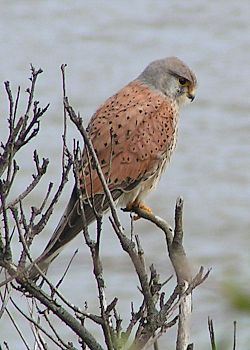Kestrel facts for kids
Quick facts for kids Kestrel |
|
|---|---|
 |
|
| Adult male common kestrel | |
| Scientific classification | |
| Kingdom: | |
| Phylum: | |
| Class: | |
| Order: | |
| Family: | |
| Genus: |
Falco (in part)
|
The name kestrel is given to several different members of the falcon genus, Falco. Kestrels hover about 10–20 metres (35–65 ft) over open country, and swoop down on prey, usually small mammals, lizards or large insects. Other falcons are more adapted to active hunting on the wing. In addition, kestrels have much brown in their plumage.
Kestrels can fly in stationary air, even indoors in barns. While hovering they face towards any slight headwind. This leads to the common kestrel being called a "windhover" in some areas.
Unusually for falcons, plumage often differs between male and female, although as usual with monogamous raptors the female is slightly larger than the male. This allows a pair to eat slightly different prey on their home range. Kestrels are bold, and have adapted well to humans. They nest in buildings and hunt by main roads. Kestrels do not build their own nests, but use nests built by other birds.
About 2.5 million years ago, the main line of true kestrels emerged. This seems to have evolved in Africa and spread across the Old World until they reached Australia some time during the Middle Pleistocene, less than one million years ago.
This group contains several populations found on Indian Ocean islands. A group of three mainly grey species from Africa and Madagascar are usually considered kestrels by their general shape and habits, but are probably distinct from the true kestrels.
There is only one kestrel in the Americas, with a wide range of habitats. It is Falco sparverius. The male is more brightly coloured than usual for kestrels, with a reddish back and tail.
Images for kids



